The Garden City of the East
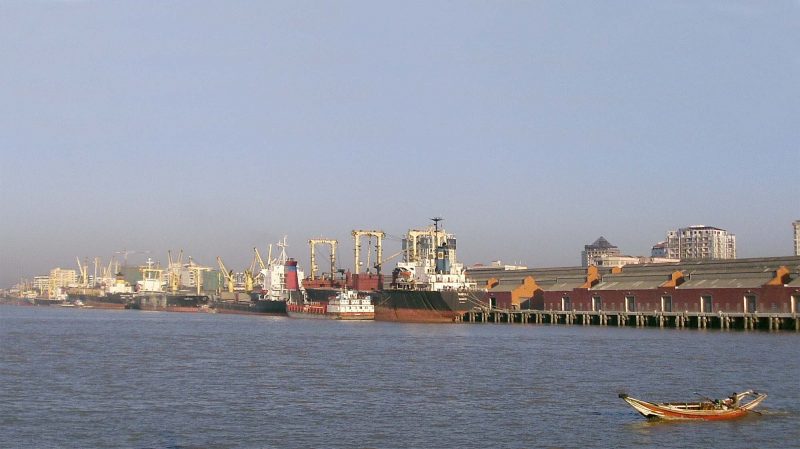
Yangon is the cultural and commercial centre of Burma, now Myanmar, with the port lying twenty one miles north of the Gulf of Martaban at the junction of the Yangon and Bago (Pegu) rivers. It handles over 36 million tonnes of cargo per annum, with the city formerly known during the British period as Rangoon, the Anglicized version of Yangon. The population of the town was only ten thousand people in 1824, but the British established hospitals including Rangoon General Hospital and colleges including Rangoon University for the growing population. Parks and green open spaces, and the Rangoon Zoological Gardens, earned the growing city the title of ‘The Garden City of the East’.
The Mahabandoola Gardens near the port are famous for its rose gardens that surround the Myanmar Independence Monument, a tall white pinnacle in the middle of beautiful flowering borders. They were originally named after the Chief Commissioner of British Burma, Albert Fytche, but were renamed in 1935 after General Mahabandoola, leader of the Burmese resistance in the First Anglo-Burmese War of 1824/26. They are a lovely place to sit and have a good view of the many old style British colonial buildings of the city, built in the ‘Neoclassical’ and ‘Indo-Saracenic’ styles of architecture.
The population in the inter-war years had grown to almost half a million, with Burmese, Indian, South Asian, Chinese, Anglo-Burmese and other racial groups such as the Karen people of Southern Burma. The latter racial group make up 7% of the Burmese population with five million people now living in Yangon city, Southern Burma, and on the Burmese and Thai borders. The women are famous for wearing traditional and elaborate neck rings, and this ethnic grouping waged a war against the central Burmese Government from 1949 to 2012, fighting for the right to govern their own State. Burma and Yangon were under Japanese military rule during World War II, with Rangoon Docks almost completely destroyed by the Japanese on their withdrawal in May 1945.
Yangon is a major exporter of rice and rice products, as well as of teak and hardwoods from the mountains to the north. The country is self sufficient in oil from deposits in the north, and natural gas production is increasingly important. The primary religions are Buddhism, Christianity, Hinduism and Islam, with secessionist moves in Muslim Arakan State. The population of Yangon is expected to reach 6.361 million by 2020, but few have mobile or landline telephones, with the telephone penetration only 6% to 10% during the last decade. The high cost of telephone networks, computers and the heavily restricted Internet and local Intranet by the military government are the reasons, with Internet cafes the only solution. The media is heavily censored by the military government Press Security and Registration Division, with the editors of newspapers careful to publish only editorial content in line with Government policy.

History Of Yangon (Rangoon)
Yangon was founded as Dagon in the early eleventh century by the Mon people, who really dominated the lower area of Burma at that time. Dagon was a small fishing village centred around the golden Shwedagon Pagoda, a huge, dramatic temple best seen at sunset or sunrise. The British invaded Burma three times in 1824/26, in 1851 and in 1885, each time fighting a war against the Burmese. During the first war, the British captured Yangon, but returned it to Burmese administration after the war. The Second War was fought in 1851 after a dispute at Yangon had escalated into open conflict. The First and Second Wars were not about the usual acquisition of territory, and more about the Burmese, with their long history of monarchy and a superior, supercilious attitude, and their refusal to accept what Britain, as ruler of India, saw as modified independence.
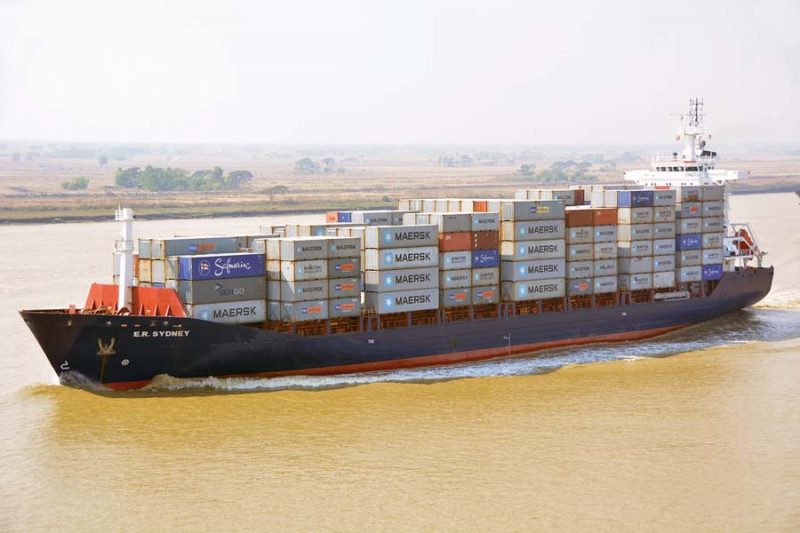
Britain captured Upper Burma during the third Anglo Burmese War of 1885, after the British resident was forced to withdraw in 1879. Adventurers and concessionaires had arrived in Mandalay in greater numbers and from a wider range of countries including France. The Bombay-Burmah Trading Company had provoked an incident that led to this war, but Burma again could never accept the kind of semi-independent status the British considered it should accept as an example of a ‘watered down’ version of their powerful territorial domain of India. Lord Randolph Churchill, father of Sir Winston Spencer Churchill, wanted Burma to be added to the many British worldwide dominions before any other European power might appear in Burma.
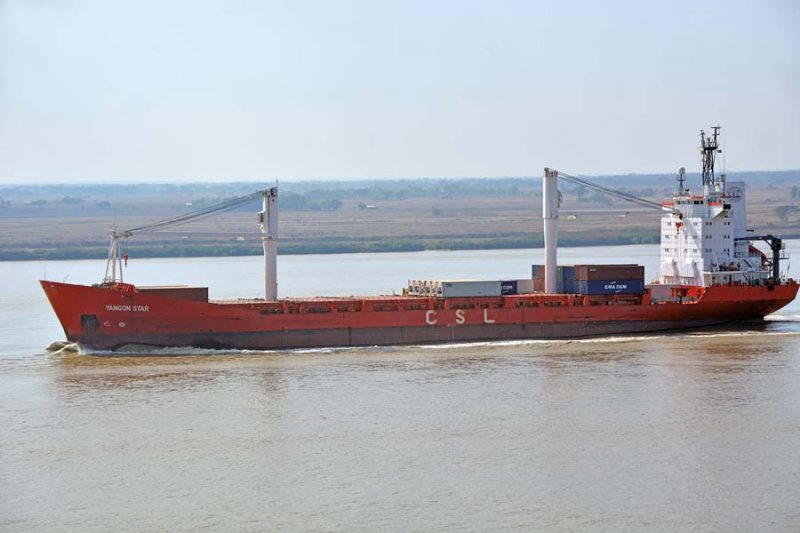
Under the British Empire, the Port of Rangoon was rebuilt on the delta area of the southern part of British Burma with Rangoon as its capital. The town of Rangoon was detached from the main district called Hanthawaddy in 1880 and formed into a separate district, of which half of the immigrants were from India.
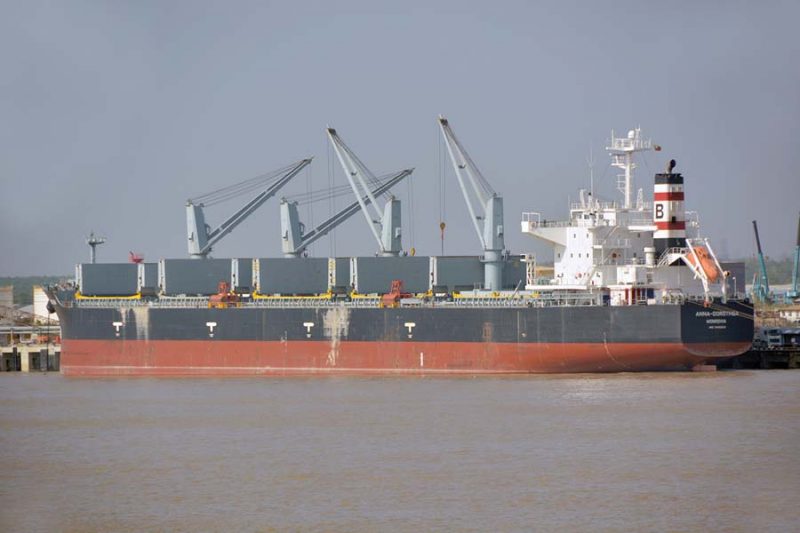
Rangoon became the capital of the Union of Burma on 4th January 1948 when the country regained its independence from the British Empire, a very much cherished ambition. Nearly all of the colonial street names and parks were changed to Burmese names, with the ruling military junta taking power in 1959. In the 1950s, there were only four wharves in the port, named Sule Pagoda Wharf of length 2,100 feet, Ahlone Wharf of length 475 feet, Brooking Street Wharf of length 900 feet, and New Wharf of length 550 feet, with alongside depths ranging from twenty feet to thirty feet. All other large ships not at these rice mill and teak wharves moored to numerous swinging buoys in the harbour. There were also two sets of fixed moorings for tankers off Seikkyi, and a swinging mooring for cargo-liners at Kemmendine. The depth of water in the Monkey Point Dredged Channel was variable, ranging from 12.5 feet to 16.0 feet at low water in the dry season, with the depth of water on the Outer Bar also at 16.0 feet at low water in the dry season.
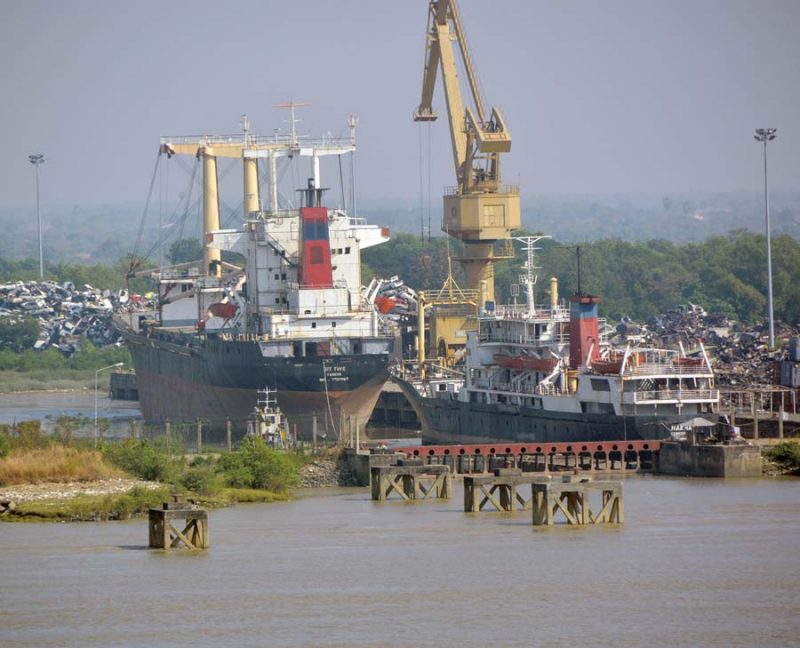
Myanmar officially became the name of the country of Burma in 1989, and Rangoon changed to Yangon. Burma has been in isolation from the rest of the world for sixty years, with international sanctions against the country due to its military rule. The military stepped aside in 2011, and a new democracy took over, however the current military oppression of the Rohingya Muslim people, citizens of Myanmar, show that Myanmar is a democracy in name only.
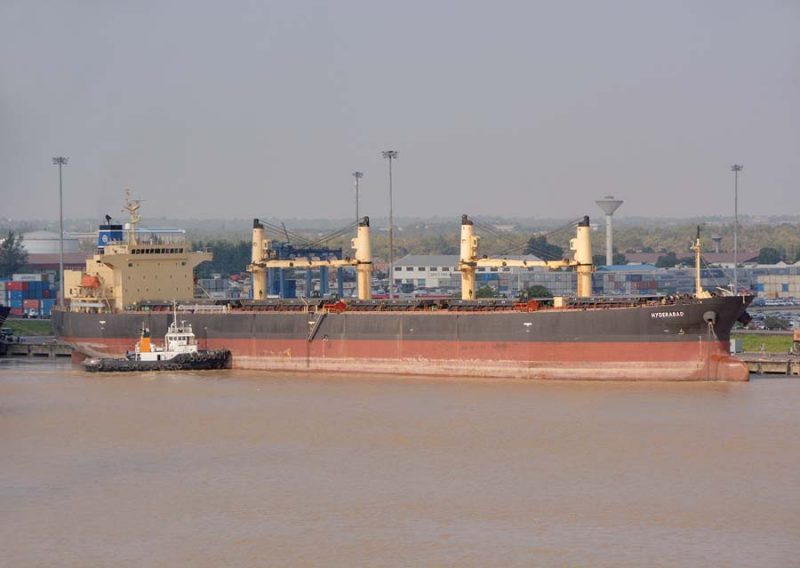
The Golden or Shwedagon Temple still glows each day in the morning sun to dominate the Port of Yangon skyline, and welcomes large numbers of international tourists to the city. According to legend, this huge Buddhist pagoda of ninety metres in height was built when Buddha lived here, and it is the most sacred Buddhist pagoda in the country, with relics from four past Buddhas enshrined here including some of the hair of the historic Buddha, called Gautama.
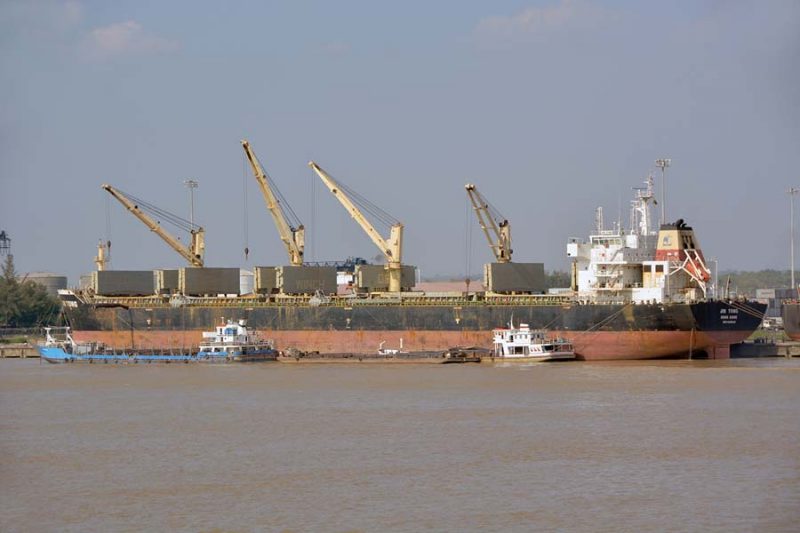
Myanmar Port Authority (MPA)
The Port of Yangon handled 24.328 million tonnes of imported cargo in 2016, and 9.985 million tonnes of exported cargo to give a combined total of 34.313 million tonnes. Non containerised cargo consisted of 15.719 million tonnes of imported cargo, and 6.537 million tonnes of exported cargo, with containerised cargo making up the remaining tonnage with a total of 1.027 million TEU of containers handled during 2016.
The modern era of the Port began in 1880 with the establishment of the Commissioners for the Port of Rangoon. In 1954, the Board of Management for the Port of Rangoon was established, and the Burma Ports Corporation in 1972. The Myanmar Port Authority was established in 1989 to replace the Burma Ports Corporation. Vessels up to recently have been limited to reaching the city berths to 16,000 tonnes deadweight, but an ongoing dredging contract with CCCC TDC Tianjin Dredging of China will see this limit extended upwards to 35,000 tonnes deadweight. Trailing suction hopper dredgers in the port in the past have included the twin screw Cormorant of 1,248 grt completed by William Simons and Co. Ltd. at Renfrew in December 1913, and she was replaced in post-war years by the similar twin screw dredger Thaung Naing Yay in 1962 with dimensions of length seventy metres and beam of twelve metres. The present port dredgers are two sisters, Ramanya and Areindamar of 1,575 grt, built in 1989 of length 68.8 metres and beam of 14.2 metres.
The Myanmar Port Authority (MPA) administers all of the ports in the country including the Port of Yangon, which is the premier port of Myanmar and handles 90% of its trade. The MPA has been a member of the International Ports and Harbours since 1957, and it joined the ASEAN Port Association in 2005. Port charges include Port Dues, Light Dues, Pilotage fees, Berthing and Stevedoring fees, Export Conservancy charges, Port Salvage and Equipment Hire charges, Container Handling charges as well as other charges.
The Thein Phyu Dockyard is owned by the MPA and during 2009 to 2011 it built six small tugs and coasters with bow ramps of up to 1,920 grt. The yard is located near the port, and the output was for Myanmar shipowners, and earlier it had built four oil rig supply vessels for Jaya Offshore Pte Ltd., Singapore in Jaya Gold, Jaya Hercules, Jaya Transporter and Jaya Transporter II. The yard also built the tug Forceful Performer, and the yacht Myanmar Y397. Two new port facility vessels were constructed in 2014 by the Thein Phyu Dockyard for the MPA for use in the Port of Yangon at a cost of K40 million.
The local ferries that cross the Yangon river to the townships of Dala and Thanlyin use four main passenger jetties located on or near the downtown waterfront. There are also regional ferries to the Irrawaddy delta via the Twante Canal of 22 miles in length. This is the quickest route by water to the Irrawaddy delta, but the road connection is now better and is used all of the year. Tourist river cruises on the Irrawaddy from the delta to Upper Burma still operate but the passenger and cargo boats of the Irrawaddy Flotilla owned by ‘Paddy Henderson’ of Glasgow are long gone.
Port Of Yangon Berths and Facilities
Myanmar Port Authority (MPA)
Hteedan Rice Berths of total length 320.0 metres with two berths and 21,700 square metres of yard space and a warehouse of 6,700 square metres exporting rice and rice products.
Sule Pagoda Wharves of total length 1000.0 metres with seven berths and 36,800 square metres of yard space and warehouses of 67,500 square metres. They handle containers and general cargo with reach stackers and other container handling equipment. The Sule Pagoda is located in the heart of downtown Yangon near the river, and according to legend, was built before the more famous Shwedagon Pagoda, making it over 2,600 years old.
Port Health Jetty of 91.0 metres in length and a warehouse of 4,400 square metres and handles general cargo.
Bo Aung Gyaw Wharves of total length 457.0 metres with three berths and 60,700 square metres of yard space and a capacity of 2,622 TEU of container storage for full, empty and reefer containers.
Botatung Container Depots, two inland depots in number, with a total yard space of 106,100 square metres and a capacity of 7,222 TEU of container storage for full, empty and reefer containers.
Myanmar Port Authority equipment includes a 40 tonne Gantry Crane, a 40 tonne Mobile Crane, ten forklifts of up to 40 tonnes capacity, two tractors of 10 tonne capacity, a 40 tonne prime mover, two trucks, and a water bowser of 1,600 gallons capacity.

Myanmar Industrial Port (MIPP)
Myanmar Industrial Port Wharves of total length 310.0 metres with three berths and yard space of 102,400 square metres of yard space and warehouses of 6,100 square metres.
Ahlone Wharves of total length 614.0 metres with three berths and 55,700 square metres of yard space and a warehouse of 6,100 square metres. Ahlone Wharf 3 has a yard capacity for 4,651 TEU of containers.
Thaketa Wharves of total length 212.4 metres, two berths with 16,300 square metres of yard space and warehouses of 4,500 square metres.
They handle general and liquid cargoes, and coastal traffic and their passengers. Myanmar Industrial Port equipment includes a 100 tonne Gottwald crane, a 100 tonne Genma crane, two Liebherr cranes of 180 to 200 tonne capacity, a 150 tonne Demag crane, a 90 tonne Mobile crane, a 50 tonnes Kato crane, together with smaller cranes, reach stackers, forklifts, and other equipment.
Myanmar International Thilawa Terminal (MITT)
MITT Wharves of total length 1,000 metres, two in number, with 500,000 square metres of yard space and warehouses of 20,000 square metres. Thilawa Port is situated on the east bank of the Yangon river fifteen miles from the city wharves and is a one hour drive to the centre of Yangon. The cargo piers have an alongside depth of between 31 and 35 feet, and larger cruise ships belonging to Holland America Line, Regent Seven Seas and Oceania Cruises, Crystal Cruises, Seabourn Cruises, Silversea Cruises, Phoenix Seereisen, Azamara Cruises, and Voyages to Antiquity berth here during the cruise season lasting during the dry December to March period. Smaller cruise ships dock in the city at the Bo Aung Kyaw Jetty or the Nanthida Jetty, but cruise passengers should note that all of these cruise ship berths are open jetties with no passenger terminal facilities. The city berths are a short walk from the Shwedagon and Sule Pagodas, the Strand Hotel and the famous Monsoon Restaurant.
MITT berth equipment includes a 40 tonne quay crane, a 40 tonne gantry crane with three more having arrived during July 2017, reach stackers, container tractors, trailers and forklifts up to fifteen tonnes in capacity.
Myanmar Integrated Port Terminal (MIPL)
MIPL Wharf of length 200.0 metres and 20,000 square metres of yard space, and 3,000 square metres of warehouse space. MIPL equipment includes a large Single Line Grabber of capacity 3.5 cubic metres, and Palm Oil storage tanks of 6,000 metric tonnes capacity and many forklifts. The facilities of Yangon are thus adequate, considering the size of the port imports and exports.
Myanmar Five Star Line (MFSL)
The economy of Burma grew at an annual rate of 2.3% of GDP during the fifteen years from 1960 to 1975, despite the political upheavals of establishing a military dictatorship in 1959, and the establishment of a one-party State in 1974, approved by a national referendum, to form the Socialist Republic of the Union of Burma with civilian rulers. Three successive Four Year Plans from the year 1970/71 to the year 1981/82 only succeeded in slightly raising economic growth, but the United Nations Code of Conduct (UNCTAD) of cargo sharing of liner conferences for developing countries greatly helped the foreign balance of payments. The establishment of a National Shipping Line in 1959 as the Burma Five Star Line on the principle of 40:40:20, with 40% of the main U.K. and Europe to Burma Liner Conference trade to the developing country of Burma, 40% retained by the developed European countries, and 20% of trade to cross traders helped the growth of the nation. Similar fleets were set up on this understanding by the Nigerian National Shipping Line, and the Ghana Black Star Line. These two fleets had built up a combined total of 28 cargo-liners of up to 10,500 dwt by 1973.
The first deep sea cargo ships in the new fleet were ordered from German and Japanese shipbuilders soon after the formation of the national line, and were completed in 1963 as two sets of sisters Ava and Bassein, and Mergui and Pinya, both of 10,120 dwt with engines ‘midships and five holds and five hatches. Mergui and Pinya were given heavy lift derricks, and all four had red funnels with a central blue band carrying five white stars, with the houseflag being the same, and black hulls with ‘FIVE STAR LINE’ in large white block capitals.
A coastal fleet of white hulled passenger and cargo vessels operated west to the Rakhine Coast ports of Thandwe, Kyaukphyu and Sittwe, as well as south to the Thanintharyi Coast and the ports of Mawlamyine, Dawei, Myeik and Kawthung, and grew in size with the growth of the deep sea fleet. Two white hulled engines ‘midships coastal passenger and cargo ships were built in 1955 by Fleming and Ferguson as Pyidawaye and Pyidawnyunt of 2,217 grt for the Burma Government Shipping Company. The latter closed down in 1960, with Pyidawaye transferred to the Navy as a troopship, and Pyidawnyunt to the Burma Five Star Line. They were handsome vessels with derricks on two masts and a set of posts aft for cargo handling into three holds and hatches, dimensions of length 286.0 feet, moulded beam of 42.2 feet, and a loaded draft of 15.0 feet, and a combined bridge and poop deck of length 166.0 feet. They were steamers with triple expansion engines by the builder, and after 24 years of service Pyidawnyunt suffered a serious fire at Rangoon on 22nd January 1979, and became a total loss.
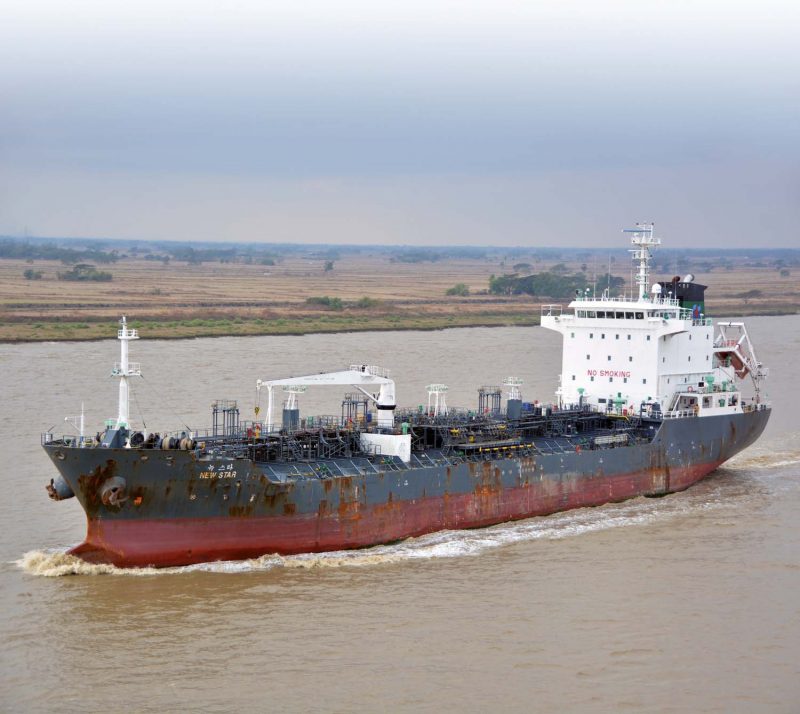
Coastal oil tankers to carry the cargo from the developing oil and gas fields to the north of the country included the war designed Yenan of 950 dwt, completed on the Tyne in 1946 as Empire Tesdale. The deep sea fleet by 1973 had grown to fourteen vessels and included Myoma Ywa of 7,085 dwt, purchased in 1969 from Hansa Line as Altenfels. She was of engines aft design with four holds and five hatches served by a Stulcken heavy lift derrick and a travelling crane at number one hatch. The older ‘midships design of the Royal Mail Line vessels Ebro and Essequibo, completed in 1952 by the Govan yard of Harland and Wolff Ltd., was favoured when they were purchased in 1970 and renamed as Kalemyo and Kalewa respectively. The fleet was expanded to one of twenty vessels, with ten deep sea ships and ten coastal ships. Four deep sea sisters of 13,105 dwt were completed in 1983 as Chin Shwe Haw, Magway, Mandalay and Sagaing by Seebeck Werft yard at Bremerhaven with strengthened hulls for heavy cargoes, container securing facilities on deck for 383 TEU of containers, and four holds and five hatches served by five cranes of 25 tonne capacity. They had service speeds of sixteen knots from a five cylinder single acting B & W oil engine of 9,050 bhp.
The size of the long established British cargo and passenger fleets of ‘Paddy’ Henderson and Bibby Line trading to Rangoon fell in line with the growth of the Myanmar Five Star Line. Henderson Line had a large fleet of eighteen vessels in 1959 including a dozen ‘K’ class of 9,500 dwt built by the Lithgows yard at Port Glasgow between 1952 and 1958. The Bibby Line fleet consisted of six passenger and cargo ships, with Herefordshire of 10,400 dwt and completed in 1944 by the Barclay, Curle yard on the Clyde, on charter to Port Line as Port Hardy. The Henderson Line service to Burma was heavily reduced in 1965 and finally ceased in June 1967 when the Suez Canal was blocked by the Arab/Israeli War, and the last ships Bhamo, Pegu and Yoma were transferred to the ownership of the Guinea Gulf Line and Elder Dempster Ltd. Henderson had thus disappeared into the Elder Dempster fleet of Ocean Transport and Trading Ltd., and arrangements were made with Bibby Line in 1968 to handle all of the Henderson Burma requirements, and their Gloucestershire of 8,640 dwt, built as Cingalese Prince in 1950, closed out the Burma service when she sailed from the West Float in Birkenhead for Burma in 1971.
The Myanmar Five Star Line (MFSL) fleet in 2004 was a large one of 26 vessels, with a dozen deep sea general cargo, multi-purpose and ro-ro vessels. The quartet of the German built Bago ex Chin Shwe Haw, Magway, Mandalay and Sagaing were still trading for the company, while the German built sisters Mawlamyine and Sittwe of 11,660 dwt and the Chinese built sisters of Dawei and Kengtung of 11,654 dwt all had container carrying capacities of 382 TEU to 400 TEU. There were also four coastal cargo ships of 3,300 dwt, and ten coastal passenger ships in the fleet. The latter consists of the white hulled sisters Chindwin and Thanlwin, named after up country towns, carrying 440 passengers and 592 tonnes of cargo, as well as Hakha, Myitkyina and Taunggyi carrying 315 passengers and 948 tonnes of cargo. Two stern ramped ro-ros, Coco Gyun and Maan Aung of 10,290 dwt and 8,335 dwt and built in 1990/91, were purchased at the end of 2009 and the start of 2010.
Myanmar Five Star Line (MFSL) currently operate monthly services from Yangon to U.K. ports, Rotterdam, Antwerp and Hamburg, as well as to Hong Kong, Busan, and Japanese ports, while the South East Asian ports of Singapore, Bangkok and in the Straits of Malacca are also served. MFSL sold seven vessels at the end of 2014 after international sanctions had hit its services. The 18,315 dwt bulker U Thar was then purchased in 2015 for use on the European and Far East services. She had been built in 1995 by the Shikoku Dockyard at Takamatsu as Rubin Eagle for the Cebu Sealink Corporation of the Philippines with four holds and four hatches served by three cranes of thirty tonnes capacity. A service speed of 13.5 knots is obtained from a five cylinder B & W oil engine of 6,774 bhp.
The Irrawaddy Flotilla
This famous river fleet was owned by ‘Paddy’ Henderson of Glasgow, and carried cargo from Mandalay and other large towns on the Irrawaddy delta into the Port of Rangoon via the Twante Canal of 22 miles in length and the Twante river. The Irrawaddy Flotilla owned a huge fleet of over six hundred paddle steamers, barges and small craft at the end of the 1930s, and had even tried an ill-fated seaplane to move passengers to Mandalay. This was transported to Rangoon on the deck of Kemmendine of 1924, accompanied by its pilot and engineer, loaned from Imperial Airways.
The Irrawaddy Flotilla and Burmese Steam Navigation Co. Ltd. was formed on 1st January 1865 with a capital of £100,000 in two thousand shares of £50 each. The towing steamer Ava of 341 grt and four other smaller steamers, Bentinck, Nerbudda, Damooda and Mahanuddy and three non-propelled troop carrying vessels were taken over from an earlier enterprise. The first new steamer was named Colonel Phayre at the A. and J. Inglis yard in Glasgow, and together with ten new cargo-carrying ‘flats’, was added to the fleet in 1865/66. All of the Irrawaddy Flotilla river craft were assembled on the Clyde, then ‘knocked down’ into manageable sections and transported to Burma on the decks of ‘Paddy’ Henderson ships, and then reassembled at the Dalla Dockyard of the Flotilla in Rangoon. Two new paddle steamers, with either three decks or two decks, were sent out in 1867/68 named Colonel Fytche and Mandalay, the latter was of length 245 feet and capable of towing two ‘flats’.
In 1875, the fleet consisted of eleven steamers and 32 ‘flats’ including seven new steamers of the ‘Mandalay’ class and eighteen new ‘flats’. The name of the fleet was changed to the shorter Irrawaddy Flotilla Co. Ltd. on 1st January 1876. Steam power with its speed, regularity of arrival had tamed the fast flowing Irrawaddy river, which is four miles wide at certain points between Mandalay and Rangoon. During November, 1885 and the Third Anglo-Burmese War, six Flotilla steamers, ten ‘flats’ and H.M. Indian Marine ship Irrawaddy formed a group of steamers advancing up the river from Rangoon to Mandalay. The Indian Marine ship was the temporary headquarters of General H.H. Foord and his staff, and after the fighting was over in Upper Burma, this led to the annexation of the region by Britain on 1st January 1886, and the exile of King Thibaw (reigned 1878-1885), the last of the Burmese Kings.
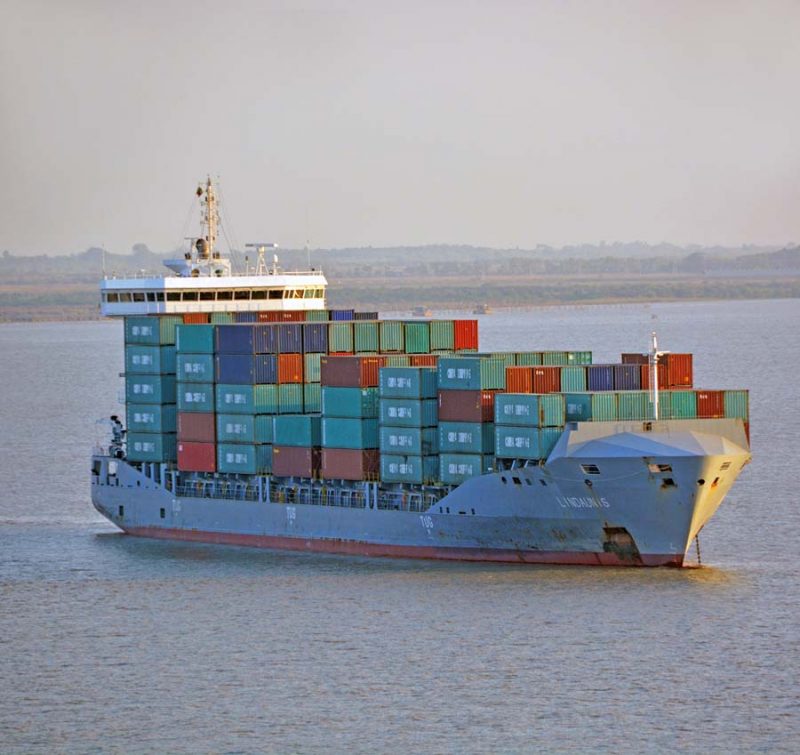
Seven new much larger river steamers capable of carrying 4,200 deck passengers and towing two ‘flats’ with a total cargo of 2,000 tonnes were ordered from the Denny yard at Dumbarton for completion in 1903 or shortly afterwards. They had dimensions of length 328.5 feet, beam of 46.1 feet, depth of 10.7 feet, with a loaded draft of six feet. On the Upper Deck, there were cabins for sixteen First Class passengers and two dozen Second Class passengers. They were named Assam, Ceylon, Japan, Java, Mysore, Nepaul and Siam, with all fitted with triple expansion steam engines by the builders to give a service speed sufficient to make the voyage from Rangoon to Mandalay in five days. Coal was imported from Britain until the 1890s, when supplies began to arrive from the coalfields of Bengal. Japan carried the Prince and Princess of Wales, later King George V and Queen Mary, in 1906 from Rangoon to Mandalay. Siam carried the Crown Prince of Siam up the river, also in 1906. Mysore carried the Viceroy of India, the Marquess of Linlithgow from Prome to Mandalay in style in 1937.
During World War I, a large total of 89 Flotilla vessels were requisitioned by the British Government for use in the Mesopotamia campaign along the Euphrates and Tigris rivers. The shallow draft craft were ideal for these shallow draft rivers, with the first to sail were seven medium sized steamers in November 1914. They were well boarded up to protect their open decks and limited freeboard, and only one of the seven, Shweli of length 230 feet, was lost when she broke her back and foundered off Ceylon. The remaining fleet of sternwheelers, ‘flats’, barges and launches also made it to the Persian Gulf with only one casualty when a sternwheeler capsized and sank in the Bay of Bengal.
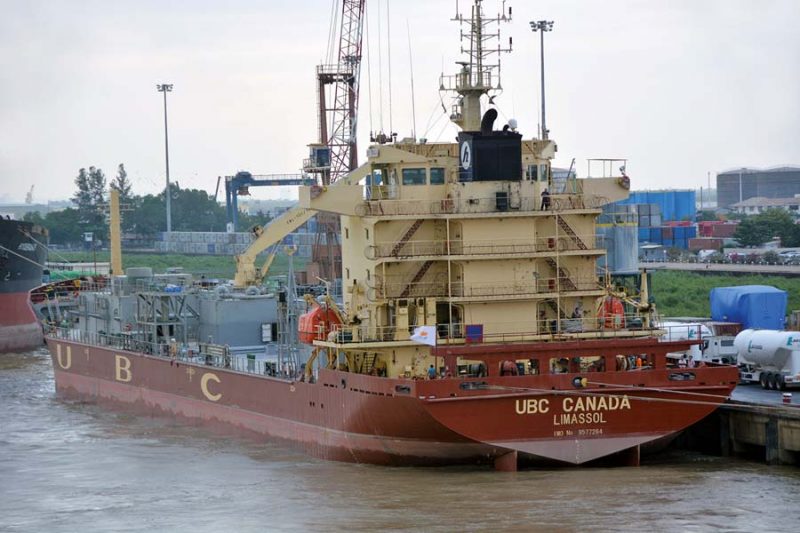
The Irrawaddy Flotilla was made famous by the verses of the poem ‘Mandalay’ by Kipling, and other works extolling the beauty of Mandalay, the second largest city of Burma. In addition to the septet described above, there were other large steamers in the fleet of length 305.0 feet carrying three thousand deck passengers. In 1932, the Irrawaddy Flotilla consisted of 66 steamers, some twin screw, and all built by the Denny, Inglis and Yarrow yards on the Clyde, together with hundreds of non propelled cargo ‘flats’, some carrying oil from the oilfields at Yenangyaung in the north. These craft carried well over half of the trade between the North and the South of the country, as the competing railway followed the line of the Sittang river to reach Rangoon from the north, with the tracks and makeshift roads of Northern Burma impassable during the monsoon season.
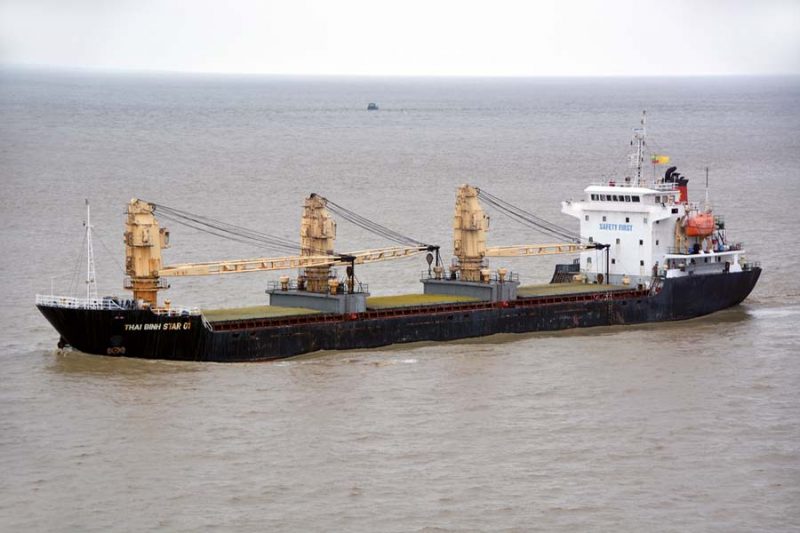
An interesting design was employed on diesel powered Thumingala built in 1939 to overcome the problems of running aground in these shallow waters.The twin screw double decked vessel was fitted with electrically operated ballast tanks capable of adding buoyancy forward or aft as the occasion demanded. The design would have resulted in more sister ships but for the outbreak of World War II, as the steamer Taping in 1912 had been aground for nine long months, and Momein grounded in 1919 for just under a year before refloating. The river steamer Amherst had the misfortune to hit a pinnacle rock at Kyaukmyaung in 1924 that pierced her hull and ripped her apart from her bow as far aft as her engine room. She was supported for some hours by the ‘flats’ she was towing, but she then turned over and sank.
Two weeks after the surprise attack on Pearl Harbour on Hawaii by the Japanese, Rangoon Docks were treated to the same heavy bombing, dive bombing and strafing, and the British troops and Irrawaddy personnel and other Europeans retreated up the river to Mandalay on the river craft, with two hundred of the fleet then sunk by the British at Mandalay and at Katha. These included thirty valuable paddle steamers of up to 1,700 grt, plus the screw steamers Chinchow, Kowchow, Soochow, and the stern wheeler Tiddim. All of the British and European personnel, together with the Irrawaddy Flotilla crews from Chittagong, then made their way into British India. At the end of World War II, advance troops of General Slim’s XIV Army re-entered Rangoon in triumph. The office staff of the imposing Irrawaddy Flotilla Headquarters Building were soon hard at work, and the Flotilla was able to resume business with some of its salvaged steamers by the end of 1945.
However, the political leaders of Burma were adamant on independence, and a delegation returned from London in early 1947 with such a promise. Burma was granted independence on 4th January 1948 with the British flag hauled down for the last time at Government House in Rangoon. On 1st June 1948, the Irrawaddy Flotilla was nationalised and replaced by the Burmese State owned Inland Water Transport Board. ‘Paddy’ Henderson was compensated for 105 salvaged craft plus some assets.
Thirteen new diesel powered river craft were then built up to 1956 by Denny and Yarrow for the Inland Water Transport Board. The Government of the Union of Burma owned ten river craft in 1973, consisting of the hopper dredgers Salween 750/53 and Mee Pya 856/54 built by Fleming and Ferguson, three twin screw tugs Tarotyua 134/14, Allison 175/19 and Panhlaing 166/30, and five diesel powered craft of 200 grt built in the 1960s.
Time has not been kind to this once large fleet, with only Minthamee from the Yarrow yard in 1948 known to be in existence today, having been employed as a Government yacht for many years. The Irrawaddy Flotilla was one of the great river fleets of the world, on a par with those on the Amazon, Nile and Parana rivers, and it passed after well over one hundred years into the realms of maritime history.
Postscript
The Myanmar Port Authority (MPA) is actively increasing the depth of the main channel into Yangon over the sand bar with the help of large Chinese suction dredgers of the CCCC TDC Tianjin Dredging. The MPA has also signed Letters of Co-operation in the last few years with the Ports and Harbours Bureau of Japan (MLIT), the China Harbour Engineering Co. Ltd. (CHEC), the Port Authority of Thailand (PAT), and the Busan Port Authority (BPA), Ministry of Oceans and Fisheries, Korea.

The Myanmar Five Star Line has deep sea liner services, and frequent services to the Rakhine State in the west, and to the Tanintharyi State in the South.
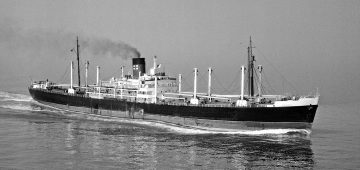



Comments
Sorry, comments are closed for this item